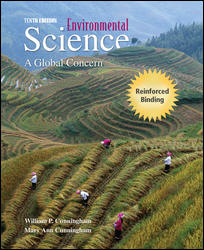Note the smokestack shadows, as well as the uniform color of the landscape. Smelting (heating ore to extract minerals) produces large amounts of acidic air emissions that can damage or destroy vegetation downwind of a smelter. If you zoom out and move northeast and from this place marker, you can see that there is more than one smelter complex in the area.
1 A) There is one smokestack shadow visible. B) There are two smokestack shadows visible. C) There are three smokestack shadows visible. D) There are four smokestack shadows visible. E) There are five smokestack shadows visible. 2 A) Large holes are dug for dumping industrial wastes. B) Land-shaping for future parks or developments is being done. C) Mines appear where the ore is dug for the factories. D) Terracing is being developed for future farms. E) A new city is being carved from the landscape. 3 A) There appears to be a lot of outdoor recreational facilities near the housing. B) There is a gray pall over most buildings and a significant lack of plant greenery, indicating poor air quality. C) There is a great deal of diversity in terms of the housing structures and landscaping. D) The housing consists of small apartments and single-family homes nestled in a pedestrian-friendly, suburban environment. 4 A) Water-saturated land tends to repel contaminants and is therefore a good area to contain runoff from processing operations. B) The pools of standing water make it difficult for workers to erect runoff barriers. C) It's difficult to determine where runoff is escaping because the landscape appears so polluted already. D) When the ground is saturated, waterborne contaminants move easily through ground water and among closely spaced water bodies. E) Clearly it rains a lot and the tundra gets in everything, making everything more difficult, including containing contaminated runoff from processing. 5 A) It's difficult to find inspectors willing to work in remote locations. B) It's difficult to conduct inspections in most remote locations due to extreme climates and topographies. C) When administrative authorities are far distant, and when there is no population whose jobs are not dependent on the plant, there is no population to object to pollution, and there is no authority to complain to. Plants in more populated regions are more likely to face objections from the population. D) Remote locations are more likely to have corrupt local governments, where bored regulation inspectors can be easily bribed. E) It is no more difficult to regulate pollutants in remote locations than anywhere else.





